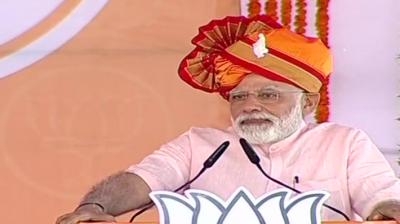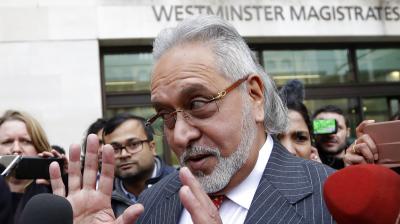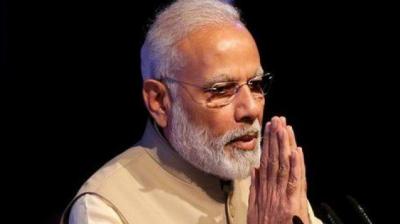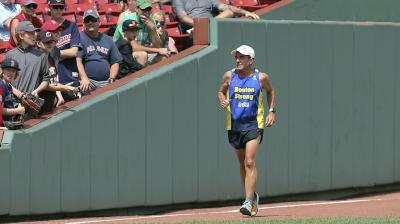
News, slider news
Seeking to make the Lok Sabha polls a contest between him and Congress chief Rahul Gandhi, Prime Minister Narendra Modi Friday asked voters to chose between ‘imaandar chowkidar’ and ‘bhrashtachari naamdar’.
Gandhi has been hurling the “chowkidar chor hai” jibe at Modi to claim irregularities in Rafale deal, while the PM has been calling the Congress chief as ‘naamdar’ (dynast).
At a rally here to campaign for BJP-Shiv Sena alliance candidates of Ahmednagar and Shirdi Lok Sabha constituencies respectively, Modi said, “You have to decide the country’s future and which direction will it take in this election. “You have to chose between imaandar chowkidar and bhrashtachari naamdar. You also have to choose between heroes of India and supporters of Pakistan,” he said.
Modi said in the last five years, people have seen that his government is a strong regime which takes decisions. “You have seen Chowkidar’s government which is strong and takes decisions. Scams and decision-making delays were the order of the day during the remote-controlled government (UPA) earlier,” Modi said.
If people compare the Congress-led alliance with the NDA, the latter’s “buland irade” (strong intentions) are visible, Modi said. “During the UPA rule, bomb blasts were frequent in which farmers, middle class people and traders were killed. Blasts happened in trains, buses and stations. But under the Chowkidar’s rule, where are the bomb blasts,” he said. “This is because the Chowkidar has instilled fear in minds of the terror perpetrators that even a single mistake would prove costly for them. The Chowkidar will find them from hell and punish them,” Modi said, asking the crowd if it agreed with his policy of eliminating terrorists by going into their territory and killing them.
Modi said the earlier government looked weak “in front of Pakistan and rest of the world”. “Our army wanted to take revenge but the (then) government kept quiet. This Chowkidar gave permission (to army) to kill terrorists by going inside their territory. Are you happy with this strong government,” he said.
On the National Conference demanding Prime Minister’s post for Jammu and Kashmir, Modi said, “the Congress and NCP are supporting those who demand that Jammu and Kashmir have a Prime Minister.” “I have no expectation from the Congress since it has stopped thinking about people long ago,” he said. “This sin is the creation of that party,” he added.
Modi said NCP chief Sharad Pawar had quit the Congress in the name of the country. “Sharad rao, how can you be silent on the two PM demand. Why are you silent? Is this acceptable to you? “Your party’s name is Rashtravadi but you see the country through a foreign lens after allying with the Congress again. Is the name Rashtravadi in your party to fool people,” Modi said. “How can you (Pawar) sleep despite being from the land of Chhatrapati Shivaji Maharaj,” he said. Modi said the Congress wants to scrap the special powers of the armed forces.
Reaching out to first-time voters, Modi said,”those born in the 21st century will be voting for the first time. Do you agree with the weak approach of previous governments and their compromising national security? Is this acceptable to you?” Modi said he has been able to work on various development projects, including farmers welfare, because of people’s support. He expressed confidence that the “Modi sarkar” will be re-elected on May 23 when results of the ongoing Lok Sabha polls are declared.
Modi said after being re-elected to power, his government would have a separate ministry for water management.
He accused the Congress-NCP combine of being enemies of farmers. Modi said the Congress needs to be decisively defeated to ensure poverty eradication, modern infrastructure and development of all sections of society.
Continuing his tirade against Rahul Gandhi, Modi linked the IT raids on aides of Madhya Pradesh Chief Minister Kamal Nath, claiming this was “Tughlak Road chunavi ghotala” (election scam). Tughlak Road is the residence of a “naamdar neta” in Delhi where funds are being sent, Modi said. “Child nutrition funds given to Madhya Pradesh government are being used for elections. Habits of the Congress won’t go. The Chowkidar is alert and that is why he could arrest the thieves,” he said.
Notably, Madhya Pradesh Chief Minister Kamal Nath’s residence as an MP is at 1, Tughlaq Road in New Delhi, while Congress president Rahul Gandhi’s official residence as an MP is 12, Tughlak Lane in the national capital.
The Income Tax Department recently conducted raids on close aides of Madhya Pradesh Chief Minister and Congress leader Kamal Nath and others in four states on Sunday.
The CBDT, that frames policy for the I-T department, had said the department has also detected a trail of Rs 20 crore suspect cash allegedly being moved to the “headquarters of a major political party in Delhi” from the house of an important person who lives on Tughlaq Road, home to many VIPs.
“Searches in Madhya Pradesh have detected widespread and well-organised racket of collection of unaccounted cash of about Rs 281 crore through various persons in different walks of life, including business, politics and public service,” it had said.

News
Embattled liquor tycoon Vijay Mallya has submitted a “renewal application” in the UK High Court, making another attempt at appealing against his extradition to India to face fraud and money laundering charges amounting to Rs 9,000 crores.
The 63-year-old former Kingfisher Airlines boss failed in his first attempt at an application seeking “leave to appeal” in the court last Friday and had five business days to renew that application to seek a brief oral hearing before a High Court judge, where his lawyers will further plead his case against being extradited to India. “A renewal form has been received and will be listed in due course,” a High Court official said on Friday.
UK home secretary Sajid Javid had signed off on a Westminster Magistrates’ Court order for Mallya to be extradited to face the Indian courts back in February. Mallya then filed an application for permission to appeal against that decision in the High Court, which was refused by Justice William Davis, giving him a week to apply for “oral consideration” via a renewal application.
The case will now be listed in the coming weeks for a hearing before a judge, where Mallya’s legal team and the Crown Prosecution Service (CPS) – arguing on behalf of the Indian government – will go head to head to reiterate factors for and against the businessman’s extradition to Arthur Road Jail in Mumbai.
As per legal procedure in the UK, Mallya’s first written “leave to appeal” application had been passed on Justice Davis, who was to make a decision on the basis of papers submitted and rejected that application “on papers”.
A judge must now decide following an “oral consideration” in coming weeks if Mallya’s appeal can proceed to a full hearing. Meanwhile, the businessman remains on bail on an extradition warrant executed by Scotland Yard in April 2017. At the end of a year-long extradition trial at Westminster Magistrates’ Court in London last December, Judge Emma Arbuthnot had ruled that the “flashy” billionaire had a “case to answer” in the Indian courts.
The judge found there was “clear evidence of dispersal and misapplication of the loan funds” and accepted a prima facie case of fraud and a conspiracy to launder money against Mallya, as presented by the CPS on behalf of the Indian authorities.
The court had also dismissed any bars to extradition on the grounds of the prison conditions under which the businessman would be held, as the judge accepted the Indian government’s assurances that he would receive all necessary medical care at Barrack 12 in Mumbai’s Arthur Road Jail.

News, slider news
Prime Minister Narendra Modi was on Thursday named for the ‘Order of St Andrew the Apostle’ award by Russia for exceptional services in promoting bilateral ties between the two countries, a Russian embassy official said.
The Order of St Andrew the Apostle is the highest state decoration of Russia, the official said.
Modi has been conferred with the award for exceptional services in promoting special and privileged strategic partnership between Russia and India, the official said.

Youth
The sudden transition from high school to college can get stressful. Anything from making new friends, to missing the old ones, to living away from home can become daunting.
One frequent pitfall during this transition is social isolation. Loneliness, of course, can have a serious detrimental effect on a student’s mental health, potentially leading to depression.
However, according to the recent study, the findings highlight the importance of cultivating the ability to enjoy and value solitary time as a meaningful experience, rather than trying to disregard it or escape from it.
The way the first-year students manage (or not) to navigate this change has long-term implications for their academic performance and ability to stick with their studies.
Research has shown that one frequent pitfall during this transition period from high school to college is social isolation. Loneliness, of course, can have a serious detrimental effect on a student’s mental health, potentially leading to depression.
“But being alone isn’t necessarily bad,” argues a team of researchers from the University of Rochester, Carleton University in Ottawa, Canada, and Ghent University in Belgium.
“Approaching solitude for its enjoyment and intrinsic values is linked to psychological health, especially for those who don’t feel as if they belong to their social groups,” said Thuy-vy Nguyen, lead author of the study published in the journal of ‘Motivation and Emotion.’
What then marks the difference between useful and potentially detrimental solitude? The key is positive motivation, according to the researchers. A healthy, autonomous seeking of alone time is associated with greater self-esteem, a greater sense of feeling related to others and feeling less lonely.
Conversely, someone who wants to be alone because of negative social experiences will more likely experience the negative effects of solitude, such as isolation or social withdrawal. The reasons matter as they determine how we experience solitude and the benefits we can get from it, the study concludes.
Previous research had shown that spending too much time socialising during the first year of college–and as a result having little time for oneself–may be associated with poor adjustment.
But over the course of two studies, conducted with 147 first-year college students in the US (testing for self-esteem) and 223 in Canada (testing for loneliness and relatedness), the team was able to untangle the interaction between new students’ social life and their motivation for spending time alone as a predictor of their successful adjustment to college life.
Nguyen says the interplay between solitary time and our social experiences has not been empirically studied before, at least not in this way.
“In previous research, it has been framed in ways that those with more access to social connections tend to have a better time in solitude. But in our study, having a healthy motivation for solitude actually is associated with wellness for those who have less access to social connections,” says Nguyen.
First-year students who valued and enjoyed their alone time seemed to display greater psychological health.
According to the researchers, being alone does not make you a loner, which is a very easy stereotype to internalise when you first enter college–especially when you think that everyone around you is socialising when you are not.
Solitude is a personal experience for everyone, so it is a time for you to take if you want, and just explore different ways to make it a meaningful and enjoyable experience for you.

News, slider news
It was the death heard ’round the running world. In July 1984, acclaimed author and running guru Jim Fixx died of a heart attack while trotting along a country road in Vermont. Overnight, a nascent global movement of asphalt athletes got a gut check: Just because you run marathons doesn’t mean you’re safe from heart problems.
Fast-forward 35 years, and Boston Marathon race director Dave McGillivray is amplifying that message for marathoners, especially those who have coronary artery disease or a family history of it.
“Being fit and being healthy aren’t the same things,” McGillivray says. He should know. Six months ago, the lifelong competitor underwent open-heart triple bypass surgery after suffering chest pain and shortness of breath while running.
As marathons, ultramarathons, megamile trail races and swim-bike-run triathlons continue to explode in popularity, doctors are re-prescribing some longstanding advice: Get a checkup first and talk with your primary care physician or cardiologist about the risks and benefits before hitting the road.
For McGillivray, 64, the writing was on his artery walls. Both of his grandfathers died of heart attacks; his father had multiple bypasses; his siblings have had heart surgery; and a brother recently suffered a stroke.
Neither McGillivray’s marathon personal best of 2 hours, 29 minutes, 58 seconds, nor his decades of involvement in the sport could protect him.
“I honestly thought that through exercise, cholesterol-lowering medicine, good sleep and the right diet, I’d be fine,” he says. “But you can’t run away from your genetics.”
Aerobic exercise such as running, brisk walking, cycling and swimming is known to reduce the risk of heart disease, high blood pressure, stroke and certain types of cancer, and it’s been a key way to fight obesity, Type 2 diabetes, osteoporosis and more. Studies have shown those who exercise regularly are more likely to survive a heart attack and recover more quickly than couch potatoes.
But new research is providing a more nuanced look at “extreme exercise” and the pros and cons of running long. In a study published in December in Circulation, the journal of the American Heart Association, researchers in Spain found signs suggesting that full marathons like Boston may strain the heart.
They measured substances that can signal stress and found higher levels in runners who covered the classic 26.2-mile (42.2-kilometer) marathon distance compared with those who raced shorter distances such as a half-marathon or 10K.
Only about one in 50,000 marathoners suffers cardiac arrest, the researchers said, but a high proportion of all exercise-induced cardiac events occur during marathons — especially in men ages 35 and older. The Boston Marathon and other major races place defibrillators along the course.
“We typically assume that marathon runners are healthy individuals, without risk factors that might predispose them to a cardiac event during or after a race,” writes Dr. Juan Del Coso, the study’s lead investigator, who runs the exercise physiology lab at Madrid’s Camilo José Cela University. Running shorter distances, he says, might reduce the strain, especially in runners who haven’t trained appropriately.
Dr. Kevin Harris, a cardiologist at the Minneapolis Heart Institute at Abbott Northwestern Hospital, says he had a patient preparing for the Twin Cities Marathon who struggled to exceed 10 miles (16 kilometers) in training. The man’s family doctor insisted he get a stress test, and he wound up needing double bypass surgery to detour around dangerous blockages in his arteries.
“Running is good, and we want people to be active. But your running doesn’t make you invincible,” Harris says. “The bottom line is that individuals with a family history — especially men who are older than 40 and those people who have symptoms they’re concerned about — should have an informed decision with their health care provider before they run a marathon.”
That family history is crucial.
Fixx, whose 1977 best-seller “The Complete Book of Running” helped ignite America’s running boom, was 52 when he collapsed and died. An autopsy showed he had blockages in two of his heart arteries. He had a mix of risk factors. His father died at 43 of a heart attack, and although Fixx quit smoking, changed his eating habits and dropped 60 pounds, it turned out he couldn’t outrun those risks.
Facebook COO Sheryl Sandberg’s late husband, tech entrepreneur Dave Goldberg, was 47 when he died while the couple was vacationing in Mexico in 2015. Goldberg had been running on a treadmill when he fell, and an autopsy revealed he had undiagnosed heart disease.
Former U.S. House Speaker Paul Ryan, who is 49, has said his own strong family history of heart disease is what motivates him to work out regularly and watch his diet. His father, grandfather and great-grandfather all died of heart attacks in their 50s.
“If you’re going to take on strenuous exercise later in life, and especially if you have active heart disease, it’s clearly in your interest to be tested and make sure you can handle it,” says Dr. William Roberts, a fellow and past president of the American College of Sports Medicine.
McGillivray says his doctor has cleared him for Monday’s 123rd running of the Boston Marathon, which he’ll run at night after the iconic race he supervises is in the books. It will be his 47th consecutive Boston, and this time, he’s trying to raise $100,000 for a foundation established in memory of a little boy who died of cardiomyopathy — an enlarging and thickening of the heart muscle.
“Heartbreak Hill will have special meaning this year,” McGillivray says.






